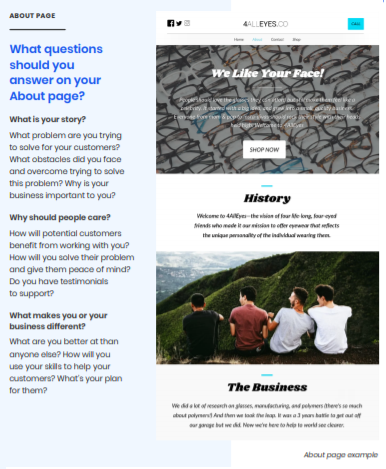
Whether you’re a photographer, writer, or visual artist, your artist biography is an opportunity to capture potential clients’ interest and show them what is truly special about your work. A bio should reflect more about your influences and values as an artist than a résumé or CV would.
Beyond its artistic integrity, your bio is a powerful marketing tool for your art. As such, it’s essential to take the time to learn how to write a bio that works for your budding art business.
Once you’ve constructed a website — using a website builder or other tools — it’s time to take an in-depth look at the steps of crafting your bio:
- Understand your audience
- Include the essentials
- Use your unique voice
- Pick a visual aid
- Tailor the length
- Proofread and edit
- Keep evolving
Understand your audience
All artists should have an online portfolio or personal website. Your artist bio is a critical piece of an effective website. It is likely one of the first things potential customers will see on your site and can impact how they perceive your work.
The most effective bios speak to a well-defined audience. Not all artists can appeal to all audiences. Instead, think about who you aspire to have as your audience. Then consider who you hope will visit your website, reach out for a collaboration, or buy your artwork.
Casual consumers as an audience
Are you planning to market your work directly to consumers via your website? If so, tailor the language in your bio to the casual consumer. Many buyers do not have a strong background or degree in art. As such, writing your bio in simple language will help ensure you don’t push customers away with dense industry jargon.
Consider reading other artist biographies selling to a similar audience and making a list of descriptive language that you like. Use similar words to describe your art and your path as an artist. The goal for marketing to the casual art consumer should be to use simple, universally accessible language.
Fellow artists as an audience
If you plan on marketing to more technical consumers — such as gallery owners, curators, or well-versed buyers — you should plan on using industry jargon. Whether you’re writing a bio to sell photography and visual art, or market your book, take care to ensure that the language aligns with the audience you aspire to reach.
Include the essentials

An effective artist bio gets right to the point. Aim to be concise while including the necessary information. Start with an outline of the essentials:
- Who you are. Include your name and any defining traits you may want to point out to your audience. Your first lines should introduce you as an artist in your unique voice.
- Where you are from and where you work now. Origin and location can have a huge impact on your art. Use these details to connect with consumers or other artists in your region.
- Your medium. While it may seem obvious, clarify what medium of art you work in — especially if you use more than one.
- Unique techniques. Do your techniques set you apart from other artists? Let your audience know.
- Essential themes. If there are central themes that drive you as an artist, be sure to share them.
- How your life has influenced your work. Your preferred themes or passions may stem from elements of your history. If you feel comfortable sharing these elements with your audience, they may help your work resonate more with potential customers or collaborators.
- What you hope to accomplish. Your influences, history, and themes can speak to what you hope to achieve with your art, but distilling it into a sentence can help your audience to truly connect with your work.
- Your art-related experience. Where has your work been featured? Have you worked as a curator or commercial artist? Don’t be afraid to share your experience if you have it.
- Education or mentors. Including any relevant education or influential mentors will give your reputation a boost.
- Important upcoming projects. Your bio is a great place to spark interest in your latest projects.
It can be helpful to write the essential points in bullets before crafting your bio in prose. Consider which points you want to highlight and include them early on in your bio.
Use your unique voice
While it may feel awkward to write about yourself in the third person — as if someone wrote it about you — this is the general standard for the artist bio. If it feels too forced, you may write in the first person.
No matter what point of view you choose, the voice should ring true to who you are as an artist. Focus on being authentic and honest.
The tone can help your voice ring through your bio. Consider the style of your work: Is it moody? Quirky? Romantic? The language in your bio should reflect that style. However, always err on the side of professionalism.
Pick a visual aid
A relevant image can add a personal touch to your bio — especially if you are a visual artist. You may choose to incorporate:
- A portrait of yourself. A photo of you, the artist, can help your audience to put a face with the name and connect on a deeper level.
- A self-portrait. If you are a visual artist, another compelling visual to include is a self-portrait. Whether it’s a photo, a painted piece, or another medium, a self-portrait can bring your bio to the next level.
- A piece that is important to you. If you explore strong themes within your work, including a piece that speaks to them is a great way to show your audience who you are as an artist.
Tailor the length
Depending on where you’re planning to use your bio, you may want to consider creating multiple versions:
- Featured work. If one of your pieces is featured in print or online, create a mini version of your bio — about 50 to 100 words long — that encapsulates your inspiration, medium, and location. Include links to your website and social media accounts.
- Website. An artist’s bio for the “About” section of your website should be about 100 to 150 words. Aim to hook your audience with compelling details, and be clear about your influences and passions.
- Portfolio. This version can run from 100 to 200 words and should focus on the themes of your work and your achievements.
Proofread and edit
As with any professional writing, it’s important to proofread and edit for clarity. Using a tool like Grammarly can help keep your bio professional and clear.
Keep evolving
You’ll want to revisit your bio every six months or so to make sure it aligns with your evolving sense of style.
Updating your artist bio is the perfect time to make sure your social media links, website, and contact info are up to date, so your customers know where to find you. Take a look at Constant Contact’s free online marketing guide The Download to learn how to incorporate your bio into your online presence.
Get started
Now that you understand how to craft a bio that speaks to your audience about who you are as an artist, it’s time to get started. Writing an artist bio can be a rewarding experience and a great opportunity to reflect on your values as an artist.




